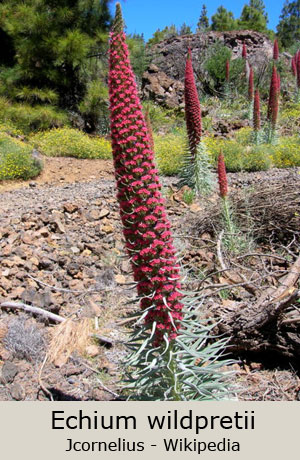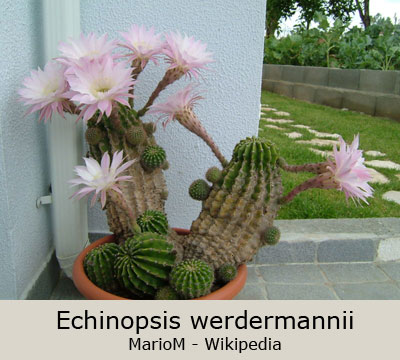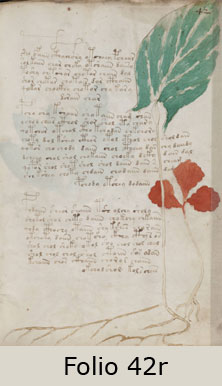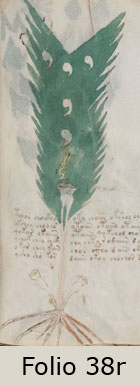The Voynich Botanical Plants

Like anyone who has viewed the Voynich Manuscript Botanical drawings, we were confused by their fantastic and eccentric characteristics. Fortunately one of us (Edith) observed that the creeper illustrated in Folio 32r was very similar to a creeper growing outside her back door. Sky flower (Thunbergia grandiflora), is a native of India. It has pairs of elongated heart-shaped leaves and clusters of light blue or white tubular flowers similar to those of bindweed. The leaves of bindweed spiral alternately along the stem. As neither sky flower nor bindweed have stamens and a pistol extending above the corolla of the flower, both creepers should be excluded as a possibility for Folio 32r. It does not seem likely that anyone living in 15th century Europe would have seen sky flower, but it made us consider the possibility that the Voynich Manuscript botanical drawings are sketches of actual plants and not copies of pictures from a Medieval herbal or products of someone’s bizarre imagination.
We therefore set about trying to match the Voynich Manuscript drawings with known herbs and weeds. Acting on the premise that the Voynich Manuscript is a 15th century Italian manuscript, we limited our selection to plants native to Europe or at least the old world and excluded all plants from the Americas. Our matches are illustrated with personal photographs, or with photographs or drawings from the Internet that are in the public domain. There are 126 drawings of plants in the Voynich Manuscript, the majority of a high enough standard to allow recognition of the plant even though the text is not readable. So far we have been able to assign names to about 124, or ~98% of the drawings. When we correlated a plant with a Voynich Manuscript drawing we tried to match the flower, the leaf, and when available the root. Modern botany does not rely on root structure for plant identification so sometimes finding drawings or photographs of plant roots is difficult.
Some of our correlations may be incorrect with respect to either genus or species. An exact match may no longer be possible due to changes from either mutation or cultivation or both. We noted that a few of the plants, like Masterwort, were on the endangered species list, so it would not be surprising for some of the Voynich Manuscript plants to be extinct. In a few cases the drawing has insufficient data to identify the plant.
After spending months correlating the Voynich Manuscript botanical drawings with 21st century plants, we arrived at the following conclusions:
- The Voynich Manuscript botanical drawings are realistic representations of living plants even if the author occasionally enhanced his drawings with fanciful embellishments like the cat’s body for roots in folio 90v.
- Many of the plants are herbs, vegetables, or flowers and are native to or cultivated in the Mediterranean region, in particular, Italy.
- In the 15th century, Italy was at the center of the crossroads of trade between the East and West. The Portuguese, under the guidance of Henry the Navigator, began exploring the African coast around 1430. This culminated in Vasco da Gama’s historic voyage in 1498 to India. Christopher Columbus discovered the “New World” in 1492. The Medici and the elite of Florence, at the center of the Renaissance, were hungry for information about Portuguese and Spanish discoveries. Europe was beset by repeated epidemics of the plague and the diet of many people was sparse and limited. The only remedy available for treating illness and accidents was the use of herbs. New plants from distant lands would have been of interest and cultivated for their food value and medicinal properties. Therefore, although plants from Africa and Asia may be suspect, they should not be automatically excluded from the list of comparisons.
- The colors used on the Voynich Manuscript botanical drawings were mainly brown, green, blue, and in a few cases, red, and yellow. We speculate that the author was strictly limited in his choice of colors and for some drawings was reduced to using only green and brown, and in a few cases, only brown. The author was probably poor and his finances limited. The inks and paints used in the Voynich Manuscript is given in Gerry Kennedy and Rob Churchill’s book (Kennedy G. and Churchill R, 2004, The Voynich Manuscript, Inner Traditions, Vermont, p.164).
- We have used 1v, 2v, 9v and 94v of the plants from the Voynich Manuscript Botanical that Dana Scott has identified. We do not agree on the other picks, this does not mean that Dana Scott is wrong; we are open to corrections. Anyone interested can check our picks against his by comparing this Web site with: Voynich Manuscript Pictures Web site.
- In all the botanical folios, the drawing was made first, then the space around the drawings was filled with Voynichese script. If the author was a young Leonardo da Vinci, he continued this practice of drawing first, writing second in his later manuscripts.
-
Finally, if you still consider the Voynich Manuscript botanical eccentric and fantastic, you should take a look at the plants below. You will realize that it is not the Voynich Manuscript botanical drawings that are fantastic, but Mother Nature, who has produced a wide variety of unusual plants for our amazement and enjoyment.




If any reader can offer a better plant, or identify an omitted folio, we will be happy to update the web site and suitably acknowledge the contributor. You may contact us at: edithsherwood@gmail.com. Two folios that we have not been able to identify or even hazzard a guess at are 38r and 42r on the right.
Before you examine the 124 comparisons, we would like to acknowledge our gratitude to Wikipedia and their contributors for most of the information and photographs used in this article. Additional information was obtained from A Modern Herbal, Vols I and II, Mrs. M. Grieve, Dover Publications, New York, 1971. This material is also available at Botanical.com. We illustrated most of our matches with:
- Personal photographs
- Photographs or drawings from Wikipedia.
- Drawings from the book by Otto Wilhelm Thomé, Flora von Deutschland Österreich und der Schweiz, published in 1885. This book has been made available online by Kurt Stueber at www.BioLib.de.
- Drawings from the book by Carl Axel Magnus Lindman, Bilder ur Nordens Flora (1901-1905), available online through Project Runeberg and mirrored at www.BioLib.de.
- Drawings from Fuchs Botanical – 1549, also available online through Kurt Stueber at www.BioLib.de.
- Drawings from Köhler’s Medicinal Plants by Franz Eugen Köhler, available online through Wikipedia.
- Drawings from Curtis’s Botanical Magazine.
- Drawings from the rare book collection at the Missouri Botanical Garden Web site.